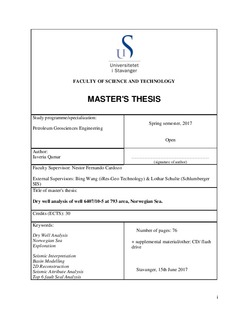| dc.description.abstract | The region of investigation is located in the Norwegian Sea, which is an area of high hydrocarbon activity. Many reservoirs have been successfully identified, drilled, and now they are producing in large oil & gas fields. However, the Norwegian Sea has a complex geology as it resulted from Permian to Late Jurassic crustal extension, which created rift basins and several horst and graben structures. Most of the important hydrocarbon reservoirs in the Norwegian Sea are Jurassic. Because of the complex geology, identifying these reservoirs and successfully positioning wells is challenging.
The research for this project is conducted on a dry well, 6407/10-5 in area 793 that was drilled along the western fault bounded Frøya High in the Norwegian Sea. The Frøya High is a Triassic paleo-uplift: a NNE-SSW trending horst bounded by the Vingleia and Klakk fault complexes on the eastern side and a major fault on the western side, which separates it from the Froan Basin. A Jurassic rollover anticline developed along the western margin of the Frøya High where the well is located. Since 2015, many fields such as Pil, Bue and Snilehorn, have been discovered in the same geological trend. However, in the study area, the two wells 6407/10-1 and 6407/10-2, drilled in the 1980s, only contain hydrocarbon shows, and the newly drilled well 6407/10-5 is dry. This study focuses on identifying the failure reason of the dry well 6407/10-5.
Newly acquired 3D seismic data covering the study area, well reports, log data and geochemical reports of the wells 6407/10-1 and 6407/10-2 are used for the project. This research provides an understanding of the geological elements of the petroleum system of the study area i.e., seal, reservoir, source and trap, which lead to debate the reasons for failure of the well. A set of methodologies are defined to test each element. Here, local source is not functional and top seal of the reservoir is heavily faulted. Trap failure is the main reason for dry well as fault besides the trap has high potential of leaking. | nb_NO |
